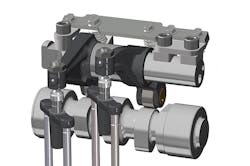Cylinder deactivation verified to improve fuel economy and slash NOx
Third-party laboratory testing has confirmed that the medium/heavy duty engine cylinder deactivation (CDA) technology developed by Jacobs Vehicle Systems improves fuel consumption by up to 5% while also being able to exponentially reduce tail pipe NOx emissions. It works by optimizing the selective catalytic reduction (SCR) system at low loads, such as idling, and at cold starts, by limiting the amount of active cylinders.
The CDA mounts on the diesel engine valve train so that the hydraulically activated system can lock a certain number of valves in place and disables injection. This increases the exhaust temperature in the active cylinders, which transfers to the SCR aftertreatment.
“The NOx output is quite a bit higher when the aftertreatment is cold – it's just basically flowing through,” explained Steve Ernest, vice president of engineering at Jacobs. “And once [the system is] hot enough, you can dose it with urea and it actually cleans up all the all the NOx."
“That gets you from like a 60 or 70% efficiency on the SCR to 99%,” he said.
The lab found that reduces tailpipe NOx emissions by 86% at the low load cycle proposed by the California Air Resources Board (CARB). Under these conditions, CO2 emissions and fuel consumption also dropped by 12%.
The EPA-funded testing was done on a 13-liter Navistar engine and targets the next cycle of emissions regulations coming as part of the Cleaner Trucks Initiative, which was announced in 2018, the same year Jacobs launched the device. The last NOx standards for on-highway trucks came in 2001 and were adopted in 2010. The EPA noted that from 2007 to 2017, U.S. NOx emissions were cut by 40%. By 2025, heavy duty trucks are still projected to produce the majority of mobile NOx emissions.
Jacobs’ CDA tech was previously demonstrated on the Department of Energy’s Super Truck II and was found to improve fuel consumption by 20% when three of six cylinders were deactivated. While a truck coasts, all the cylinders can deactivate to improve efficiency.
As of last October, the equipment had been tested on 10 heavy-duty engine platforms—ranging from 7 to 15 liters, as well as running through nearly 7,000 hours of durability testing.
The CDA is available as a collapsing valve bridge system for overhead camshaft engines or collapsing pushrod system for cam-in-block engines.
Full results will be revealed at the April 2020 SAE World Congress.
About the Author
John Hitch
Editor
John Hitch is the editor-in-chief of Fleet Maintenance, providing maintenance management and technicians with the the latest information on the tools and strategies to keep their fleets' commercial vehicles moving. He is based out of Cleveland, Ohio, and was previously senior editor for FleetOwner. He previously wrote about manufacturing and advanced technology for IndustryWeek and New Equipment Digest.


